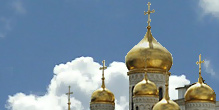 |
 |
|
|||
|
September 25ST. FIRMIN was a native of Pampelone in Navarre, initiated in the Christian faith by Honestus, a disciple of St. Saturninus of Toulouse, and consecrated bishop by St. Honoratus, successor to St. Saturninus, in order to preach the Gospel in the remoter parts of Gaul. He preached the Faith in the countries of Agen, Anjou, and Beauvais, and being arrived at Amiens, there chose his residence, and founded there a numerous church of faithful disciples. He received the crown of martyrdom in that city, whether under the prefect Rictius Varus, or in some other persecution from Decius, in 250, to Diocletian, in 303, is uncertain. ST. FINBARR, who lived in the sixth century, was a native of Connaught, and instituted a monastery or school at Lough Eire, to which such numbers of disciples flocked, as changed, as it were, a desert into a large city. This was the origin of the city of Cork, which was built chiefly upon stakes, in marshy little islands formed by the river Lea. The right name of our Saint, under which he was baptized, was Lochan; the surname Finbarr, or Barr the White, was afterward given him. He was Bishop of Cork seventeen years, and died in the midst of his friends at Cloyne, fifteen miles from Cork. His body was buried in his own cathedral at Cork, and his relics, some years after, were put in a silver shrine, and kept there, this great church bearing his name to this day. St. Finbarr's cave or hermitage was shown in a monastery which seems to have been begun by our Saint, and stood to the west of Cork. Source: http://www.sacred-texts.com/chr/lots/ The above text was published in April 2017. Read about lives of other saints
Recommend this page to your friend! |
|